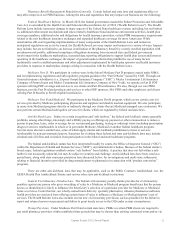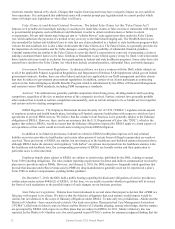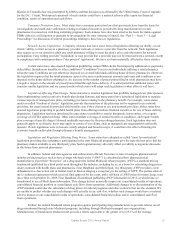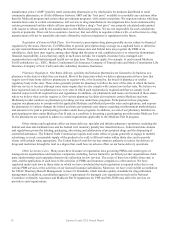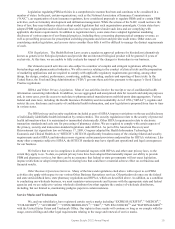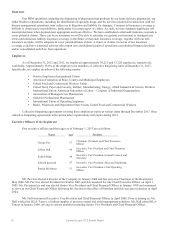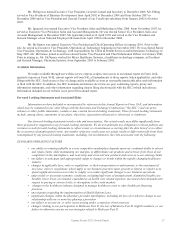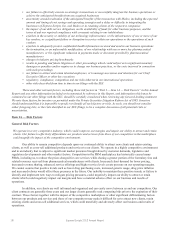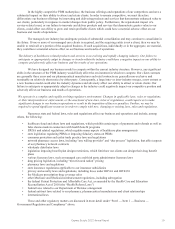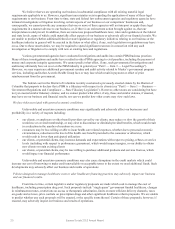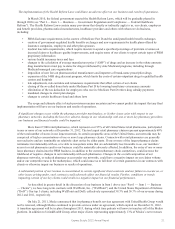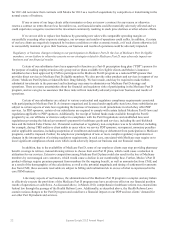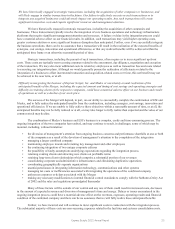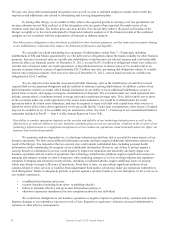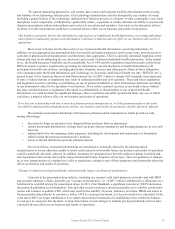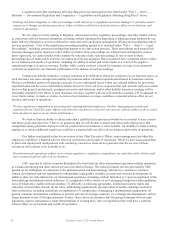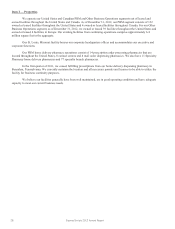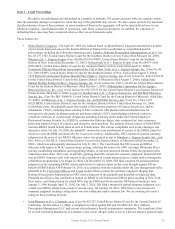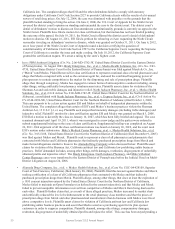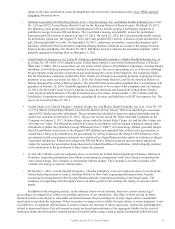Express Scripts 2012 Annual Report Download - page 23
Download and view the complete annual report
Please find page 23 of the 2012 Express Scripts annual report below. You can navigate through the pages in the report by either clicking on the pages listed below, or by using the keyword search tool below to find specific information within the annual report.
Express Scripts 2012 Annual Report 21
Q
Q
Q
Q
The implementation of the Health Reform Laws could have an adverse effect on our business and results of operations.
In March 2010, the federal government enacted the Health Reform Laws, which will be gradually phased in
through 2020 (see “Part I — Item 1 — Business — Government Regulation and Compliance — Federal Healthcare
Reform”). The Health Reform Laws contain many provisions that directly or indirectly apply to us, our clients, employers
and benefit providers, pharmaceutical manufacturers, healthcare providers and others with whom we do business,
including:
Q PBM disclosure requirements in the context of Medicare Part D and the anticipated health benefit exchanges
Q creation of government-regulated health benefits exchanges and new requirements for health plans offered by
insurance companies, employers and other plan sponsors
Q medical loss ratio requirements, which require insurers to spend a specified percentage of premium revenues on
incurred claims or healthcare quality improvements, and require some of our clients to report certain types of PBM
proprietary information
Q various health insurance taxes and fees
Q changes to the calculation of average manufacturer price (“AMP”) of drugs and an increase in the rebate amounts
drug manufacturers must pay to states for drugs reimbursed by state Medicaid programs, including through
Medicaid managed care organizations
Q imposition of new fees on pharmaceutical manufacturers and importers of brand-name prescription drugs
Q expansion of the 340B drug discount program, which limits the costs of certain outpatient drugs to qualified health
centers and hospitals
Q risk adjustments, risk corridors and reinsurance requirements that affect certain of our clients
Q closing of the so-called donut hole under Medicare Part D by lowering beneficiary coinsurance amounts
Q elimination of the tax deduction for employers who receive Medicare Part D retiree drug subsidy payments
Q mandated changes to client plan designs
Q changes to certain healthcare fraud and abuse laws
The scope and ultimate effect of such provisions remains uncertain and we cannot predict the impact that any final
implementation will have on our business and results of operations.
If significant changes occur within the pharmacy provider marketplace, or if other issues arise with respect to our
pharmacy networks, including the loss of or adverse change in our relationship with one or more key pharmacy providers,
our business and financial results could be impaired.
More than 67,000 retail pharmacies, which represent over 95% of all United States retail pharmacies, participated
in one or more of our networks at December 31, 2012. The ten largest retail pharmacy chains represent approximately 60%
of the total number of stores in our largest network. In certain geographic areas of the United States, our networks may be
comprised of higher concentrations of one or more large pharmacy chains. Contracts with retail pharmacies are generally
non-exclusive and are terminable on relatively short notice by either party. If one or more of the larger pharmacy chains
terminates its relationship with us, or is able to renegotiate terms that are substantially less favorable to us, our members’
access to retail pharmacies and/or our business could be materially adversely affected. In addition, the entry of one or more
large pharmacy chains into the PBM business, in addition to the current pharmacy chain competitors, could increase the
likelihood of negative changes in our relationship with such pharmacies. Changes in the overall composition of our
pharmacy networks, or reduced pharmacy access under our networks, could have a negative impact on our claims volume
and/or our competitiveness in the marketplace, which could cause us to fall short of certain guarantees in our contracts with
clients or otherwise impair our business or results of operations.
A substantial portion of our revenue is concentrated in certain significant client contracts and our failure to execute on, or
other issues arising under, such contracts could adversely affect our financial results. Further, conditions or trends
impacting certain of our key clients could result in a negative impact on our financial performance.
As described in greater detail in the discussion of our business in Item 1 above (see “Part I — Item 1 — Business
— Clients”), we have long-term contracts with WellPoint, Inc. (“WellPoint”) and the United States Department of Defense
(“DoD”). Our top 5 clients, including WellPoint and DoD, collectively represented 39.3% and 56.7% of our revenue during
2012 and 2011, respectively.
On July 21, 2011, Medco announced that its pharmacy benefit services agreement with UnitedHealth Group would
not be renewed, although Medco continued to provide services under an agreement, which expired on December 31, 2012.
A transition agreement will be in place throughout 2013, during which time patients will move in tranches off of the Medco
platform. In addition to UnitedHealth Group, other major clients representing approximately 13% of Medco’s net revenues


